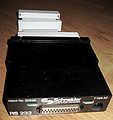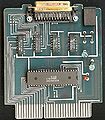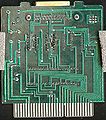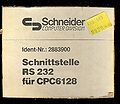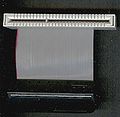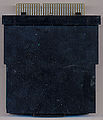Difference between revisions of "Schneider RS232 Interface"
| (27 intermediate revisions by 5 users not shown) | |||
| Line 1: | Line 1: | ||
| − | RS232 Interface for the CPC by [[Schneider]]. Schneider is the | + | [[RS232]] Interface for the CPC by [[Schneider]]. Schneider is the German distributor for Amstrad CPC hardware (however, this interface was Schneider's own invention, not an [[Amstrad]] product). |
| − | interface | + | |
| + | == Clones == | ||
| + | |||
| + | The original [[Schneider RS232 Interface]] was released around 1985. Two years later, in 1987, a software-compatible clone was released as DIY schematic in a German book ([[Maschinenspracheprogramme und Hardware-Erweiterungen für Schneider CPC's|link]]). Even later, around 1996, a copy of that DIY schematic also circulated in the internet ([[Tim Riemann's RS232 interface|link]]). The DIY port address, timings and handshake signals are exactly the same as in the original Schneider version - except that DCD (Data Carrier Detect) isn't implemented in the DIY version. | ||
== Pictures == | == Pictures == | ||
<gallery caption="The Schneider RS232 interface"> | <gallery caption="The Schneider RS232 interface"> | ||
| − | Image:Schneider rs232.jpg| | + | Image:Schneider rs232.jpg|Interface |
| − | Image:schneider rs232 1.jpg| | + | Image:schneider rs232 1.jpg|Description |
| + | Image:Terje Schneider RS232 PCB top.jpg|PCB top | ||
| + | Image:Terje Schneider RS232 PCB bottom.jpg|PCB bottom | ||
| + | Image:Schneider RS232 Interface.jpg|Interface | ||
| + | Image:Schneider-sio-front.jpg|Front Plate | ||
| + | Image:Schneider-sio-label.jpg|Label | ||
| + | Image:Schneider-sio-lead.jpg|Expansion Port Cable | ||
| + | Image:Schneider-sio-psu.jpg|Power Supply | ||
| + | </gallery> | ||
| + | |||
| + | <gallery caption="Schneider RS232 interface 300dpi scans by Robcfg"> | ||
| + | Image:Schneider_RS232_Unit.jpg|Interface | ||
| + | Image:Schneider_RS232_Unit_Bottom.jpg|Front Plate | ||
| + | Image:Schneider_RS232_PCB_Top.jpg|PCB Top | ||
| + | Image:Schneider_RS232_PCB_Bottom.jpg|PCB Bottom | ||
</gallery> | </gallery> | ||
== I/O Ports == | == I/O Ports == | ||
| − | + | ||
| − | + | Default I/O addresses are F8E0h-F8EFh (though the interface can be jumpered to use different addresses). | |
| − | F8E8h Z80 STI | + | |
| − | F8ECh Z80 STI USART Control Register | + | F8E0h - [[Z80-STI]] Indirect Data Register |
| − | + | F8E1h - [[Z80-STI]] General Purpose I/O Data Register | |
| − | + | F8E2h - [[Z80-STI]] Interrupt Pending Register B ;\ | |
| − | + | F8E3h - [[Z80-STI]] Interrupt Pending Register A ; | |
| + | F8E4h - [[Z80-STI]] Interrupt in-Service Register B ; not used | ||
| + | F8E5h - [[Z80-STI]] Interrupt in-Service Register A ; | ||
| + | F8E6h - [[Z80-STI]] Interrupt Mask Register B ; | ||
| + | F8E7h - [[Z80-STI]] Interrupt Mask Register A ;/ | ||
| + | F8E8h - [[Z80-STI]] Indirect Index and Interrupt Vector Register | ||
| + | F8E9h - [[Z80-STI]] Timers A and B Control Register ;\ | ||
| + | F8EAh - [[Z80-STI]] Timer B Data Register ; not used | ||
| + | F8EBh - [[Z80-STI]] Timer A Data Register ;/ | ||
| + | F8ECh - [[Z80-STI]] USART Control Register | ||
| + | F8EDh - [[Z80-STI]] Receiver Status Register | ||
| + | F8EEh - [[Z80-STI]] Transmitter Status Register | ||
| + | F8EFh - [[Z80-STI]] USART Data Register | ||
| + | |||
| + | Aside from the above 16 directly addressable registers, there are 8 indirectly addressable ones. For details on the direct & indirect registers, see [[Z80-STI]]. | ||
== Software == | == Software == | ||
| − | |||
| − | == | + | * Supported by "Starwriter". |
| + | * BASIC example (for the official version) is found in the Schneider RS232 manual (see below scans) | ||
| + | * ASM example (for the DIY version) is included with [[Tim Riemann's RS232 interface]] | ||
| + | |||
| + | == Manual (German) == | ||
| + | |||
| + | <gallery> | ||
| + | File:SchneiderSioManualPage1.jpg|Page 1 (cable / jumpers) | ||
| + | File:SchneiderSioManualPage2.jpg|Page 2 (schematic) | ||
| + | File:SchneiderSioManualPage3.jpg|Page 3 (z80-sti registers) | ||
| + | File:SchneiderSioManualPage4.jpg|Page 4 (blank / footer) | ||
| + | </gallery> | ||
| + | |||
| + | == Note == | ||
| + | |||
| + | The uncommon shape of the housing dates back to a Schneider BTX modul (which was being intended to be plugged into Schneider Television Sets). Apparently Schneider produced too many housings, and re-used them for the RS232 interface. Actually, a RS232 interface is very much the same as a BTX interface (the actual BTX modem must be rented separately from Deutsche Bundespost), so even the PCB may be (almost/exactly?) the same for both devices. | ||
| + | |||
| + | == Reviews == | ||
| + | |||
| + | A review appeared in German magazine [[CPC Schneider International]] (issue 12-1985, pages [[Media:Schneider International 8512-p038 - Schneider RS232.jpg|38]], [[Media:Schneider International 8512-p039 - Schneider RS232.jpg|39]]). | ||
| − | + | == Datasheet == | |
| − | * | + | * A [[Media:Mostek_3801_Data.pdf|"Z80 STI"]] is a 40pin [[Media:Mostek_3801_Data.pdf|MK3801]] chip from Mostek. Details on that chip are from the "MOSTEK 1982/1983 Microelectronic Data Book" (kindly made available by John Robertson). |
| − | + | ||
| − | + | [[Category:Peripherals]] [[Category:Serial_interfaces]] | |
Latest revision as of 12:21, 16 October 2018
RS232 Interface for the CPC by Schneider. Schneider is the German distributor for Amstrad CPC hardware (however, this interface was Schneider's own invention, not an Amstrad product).
Clones
The original Schneider RS232 Interface was released around 1985. Two years later, in 1987, a software-compatible clone was released as DIY schematic in a German book (link). Even later, around 1996, a copy of that DIY schematic also circulated in the internet (link). The DIY port address, timings and handshake signals are exactly the same as in the original Schneider version - except that DCD (Data Carrier Detect) isn't implemented in the DIY version.
Pictures
- The Schneider RS232 interface
- Schneider RS232 interface 300dpi scans by Robcfg
I/O Ports
Default I/O addresses are F8E0h-F8EFh (though the interface can be jumpered to use different addresses).
F8E0h - Z80-STI Indirect Data Register F8E1h - Z80-STI General Purpose I/O Data Register F8E2h - Z80-STI Interrupt Pending Register B ;\ F8E3h - Z80-STI Interrupt Pending Register A ; F8E4h - Z80-STI Interrupt in-Service Register B ; not used F8E5h - Z80-STI Interrupt in-Service Register A ; F8E6h - Z80-STI Interrupt Mask Register B ; F8E7h - Z80-STI Interrupt Mask Register A ;/ F8E8h - Z80-STI Indirect Index and Interrupt Vector Register F8E9h - Z80-STI Timers A and B Control Register ;\ F8EAh - Z80-STI Timer B Data Register ; not used F8EBh - Z80-STI Timer A Data Register ;/ F8ECh - Z80-STI USART Control Register F8EDh - Z80-STI Receiver Status Register F8EEh - Z80-STI Transmitter Status Register F8EFh - Z80-STI USART Data Register
Aside from the above 16 directly addressable registers, there are 8 indirectly addressable ones. For details on the direct & indirect registers, see Z80-STI.
Software
- Supported by "Starwriter".
- BASIC example (for the official version) is found in the Schneider RS232 manual (see below scans)
- ASM example (for the DIY version) is included with Tim Riemann's RS232 interface
Manual (German)
Note
The uncommon shape of the housing dates back to a Schneider BTX modul (which was being intended to be plugged into Schneider Television Sets). Apparently Schneider produced too many housings, and re-used them for the RS232 interface. Actually, a RS232 interface is very much the same as a BTX interface (the actual BTX modem must be rented separately from Deutsche Bundespost), so even the PCB may be (almost/exactly?) the same for both devices.
Reviews
A review appeared in German magazine CPC Schneider International (issue 12-1985, pages 38, 39).
